“They look like they’re praying,” says Catalina Ouyang, over the phone from her Brooklyn studio. The artist is recalling an image of suburban school children lining a linoleum-tiled hallway: crouched on their knees, hands over their heads. “I guess this is what you do when there is no contingency plan, you just… prostrate yourself.” It is mid-March—just before California enacts a shelter in place order that effectively locks down the state—and Ouyang has just opened her it has always been the perfect instrument exhibition at the New York’s Knockdown Center. It was scheduled to run February 19 to June 14 but is currently suspended, due to the chaos surrounding the global coronavirus crisis. Notions of contingency plans right now feel chillingly apt.
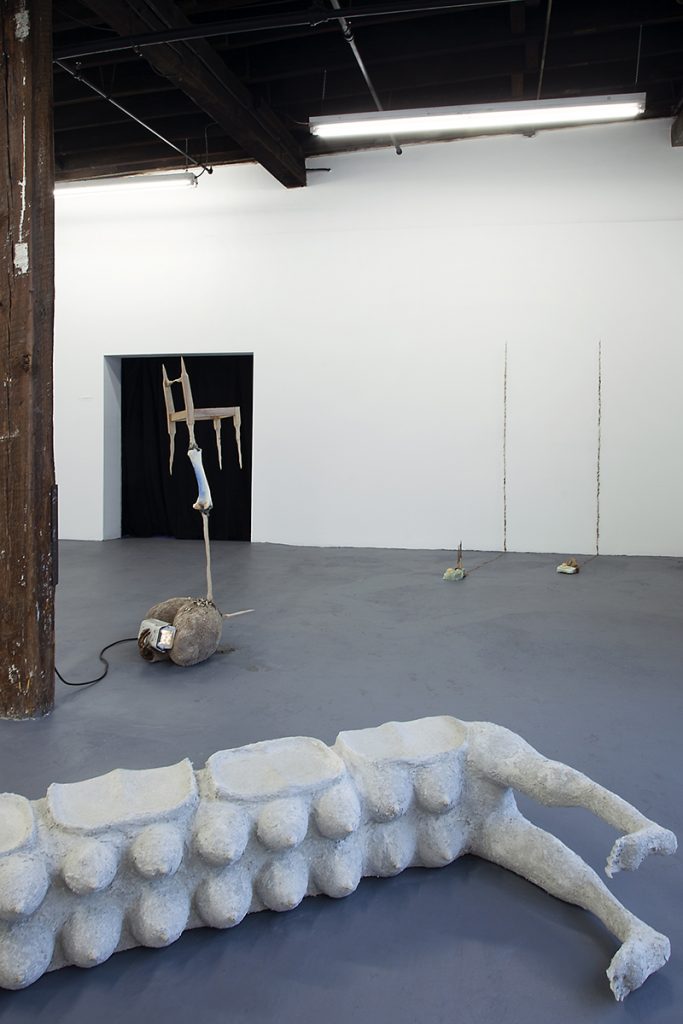
Ouyang works with a variety of approaches, including sculpture, installation, video, and participatory projects, exploring the interstices of subjugation, race, gender, and monstrosity. Searching through myth, oral history and literature, she attempts to interrupt normative processes of desire, identification and objectification. In marrow at Los Angeles’ Make Room late last year, she synthesized disparate fields of research to arrive at sculptural forms speaking of instability, self-recognition, and non-recognition, as well as trauma and its psychological ramifications. The experience of that exhibition was neither bombastic, nor laden with the sort of didactics or barriers for entry often found in work derived from research-based practices. marrow feels quiet and pensive. There is a brutality to the works, many of which demand being met on their own terms, resisting specific interpretation. The trauma is visible, but it is masked by an air of distance.
I had first met Ouyang one afternoon before marrow’s September 27 opening in Los Angeles. She was staying in a small corner studio in the Southern Californian city’s Chinatown district, filled with partially constructed sculptures, leaving little room to walk. Taking up most of the floor space was a pile of chairs, which had been hacked into pointed thrones. Perched on one of them was a carved head with a missing eye. There was a desk topped with hardened, resin-dipped undergarments in the center of the room. Below it, what looked like a human torso formed from chicken wire. A hand—carved from a fleshy pink stone and cut off at the wrist—lay on Ouyang’s worktable. There was a stack of printed photographs depicting school children participating in emergency drills next to it. In one photo, a young boy is crouched under a desk.
On seeing the marrow exhibition a few weeks later, I recognized, in one of the sculptures. The posture of the young boy from the photograph in Ouyang’s studio resonated in ‘risk assessment (but, but what made me do the bad thing?)’. The half-torso she had been working on had since been given a skin of shag carpet and moved into a corner of the gallery, facing the wall as if being punished with time-out. A hand encased in dried kombucha mothers clasps a security camera filled with moth balls. Underneath the desk sculpture at the entrance of the gallery lies another carpeted and amorphous figure, whose prone pose mimics that of the aforementioned image subject, but with an elongated arm slumped on the floor, forearm lifted and hand raising a middle finger.
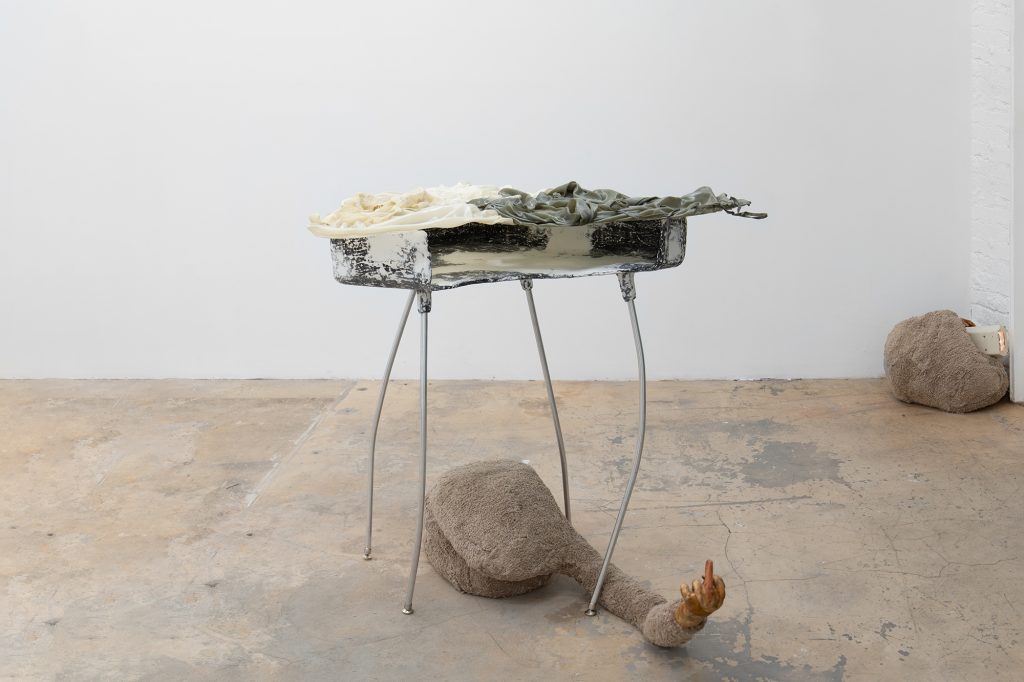
A monitor mounted on the ceiling of a second room features two chimerical CGI avatars with blank expressions punctuating a stuttering script of flashing words with gasps. The text of ‘last laugh’ includes lines like, “what happened there at that point, where were you both…” and “how did you learn everything you ever wanted…”. They weave together pieces of language sourced from texts meant to diagnose, prosecute, and integrate trauma. Together with the rest of the work in marrow enacts a cynical animosity, something close to resentment that’s born from having to harbor and endure past traumas. They’re feelings that give rise to tensions that cut across all of Ouyang’s practice.
**What formal ideas were percolating throughout your process, and how does marrow fits into your practice, broadly? What research were you doing during pre-production?
Catalina Ouyang: marrow was the first constellation of works I created after terminating both my MFA and a long-term love affair. These two endings were equally draining, and they left me without words for not the first time in my life. Emptiness is something I instinctively slide into when I feel broken. In being at a loss for words and thought, one thing I wanted to give myself permission to do was to return to the figure, without too many intellectual frills.
So, the first works that emerged were the inverted heads of ‘crisis management’. I was thinking—or perhaps feeling—through fear and transformation, particularly in myths of petrification, where a body is turned from flesh to stone out of terror, punishment, or extreme yearning. Throughout Asia, stories of ‘waiting stones’ tell of women who waited so long for the return of their husbands at sea or war that they turned into rocks. Yearning as the worst kind of patriarchal fantasy, this is also a kind of punishment. And the Gorgon Medusa, of course: her archetypal story of punishment (for disrespecting Athena by ‘allowing’ herself to be raped), retribution (a period of re-empowerment where she turned men to stone), then punishment again (murder by Perseus, for having dared self-preservation).
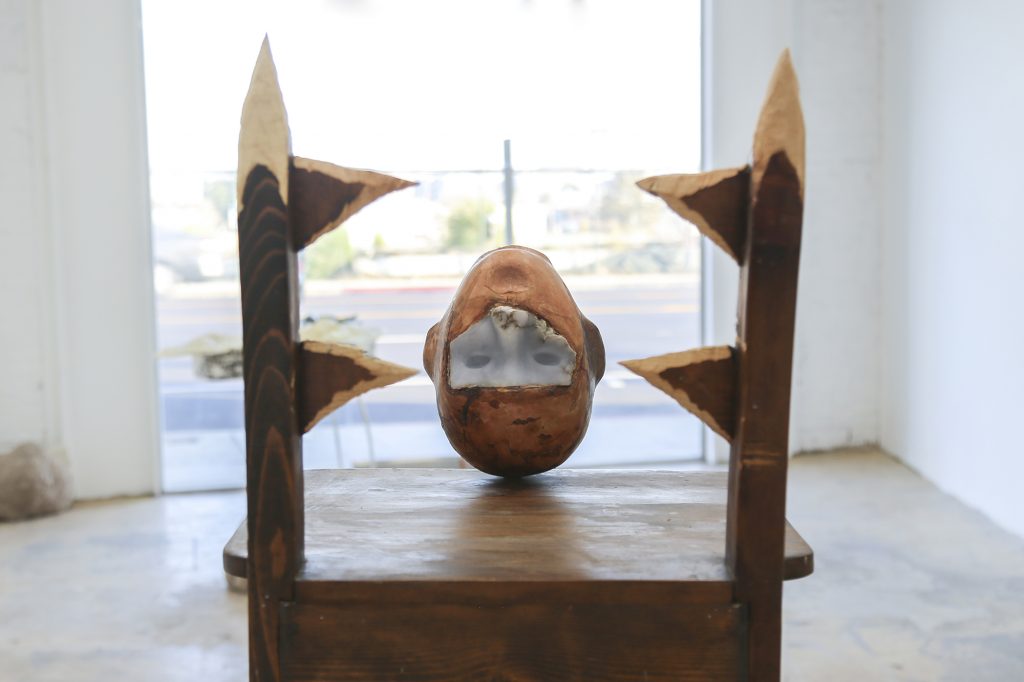
Petrification, as a state of arrested-ness, was compelling to me at the time as a generative response to trauma, specifically a ‘The Body Keeps the Score’ kind of trauma. Now, though, it feels so relevant to how the crisis of a pandemic has also ‘frozen’ entire cities and nations. In this context, I think of stillness or frozenness as a kind of long-due, enforced rest; as well as the revolutionary potential of stillness, sickness, and what would hegemonically be called ‘weakness’.
**I’m interested in the idea of a generative response to trauma in marrow. The ‘crisis management’ installation feels like more than a The Body Keeps the Score kind of trauma. The heads are decapitated, some are missing facial features, noses, eyes. Can you talk about how you arrived at these works?
CO: The heads in ‘crisis management’ are a continuation of a thought from another sculpture installation I had made at the end of 2018, titled ‘one does not know it, one does not desire it’, after a quote from Julia Kristeva. This piece involved a life-sized figure leaning over an oil drum, gazing at the carved-stone head of a pug resting on a candy dish. The figure’s face also had a carved alabaster facial insert, and it was also missing an eye. With that piece, I was thinking about wounded-ness and what is stolen from a traumatized body as it was situated in this site-specific encounter.
I was also thinking about the psychic underpinnings of diaspora and colonial dislocation. In ‘crisis management,’ I decapitated the heads because I wanted to turn them into vessels. I wanted these violated things, or persons, to be inverted into something that carries the potential for nurture—along with other connotations of the vessel, holding, carrying, an unheroic practice for creating histories. Beyond an essentialist notion of giving birth, it’s about collecting in anticipation of survival.

In ‘Evil,’ the pug also returns to gaze upon itself in the mirror, with a stone head that sits somehow separately from its reclining body. This pug-human creature is a kind of cipher, an entry point into a reading of hybridity and monstrosity. It’s a domesticated bastardization of the wolf as symbol of sexuality and the forbidden, especially as activated in Angela Carter’s and other feminist revisions of Little Red Riding Hood. But this wild wolf-woman who ultimately wins isn’t something that I relate to. There’s been too much…neutering. And distance.
With monstrosity, something else that I’m thinking about is toxicity, and how that relates—in a social sense—to what is considered “toxic” behavior, especially when it emerges from a traumatized subject position. This also relates to rage and revenge. It comes down to me trying to handle this toxicity in a way that is deeply empathetic: mournful and insistent, rather than platitudinously affirmational.
**I remember when I had visited your studio leading up to your show, you showed me reference images of children under school desks performing tornado drills. We talked about the methods by which the Western educational complex produces and reproduces fear and ideas of fear, and how that relates to intergenerational trauma and the continued effects of colonialism. Is that where your interest in this traumatic site of petrification comes from; thinking about these contorted bodies, the enduring legacy of the West’s production of fear in the othered body?
CO: While making ‘risk assessment’, my thinking about fear and transformation expanded into an assessment of the conditions that produce those responses. I was thinking very loosely about moments of crisis and emergency, and the very visceral ways that the body and psyche respond in those situations and their aftermaths; as well as the particular spaces of learning in which these responses occur, or are trained to occur.
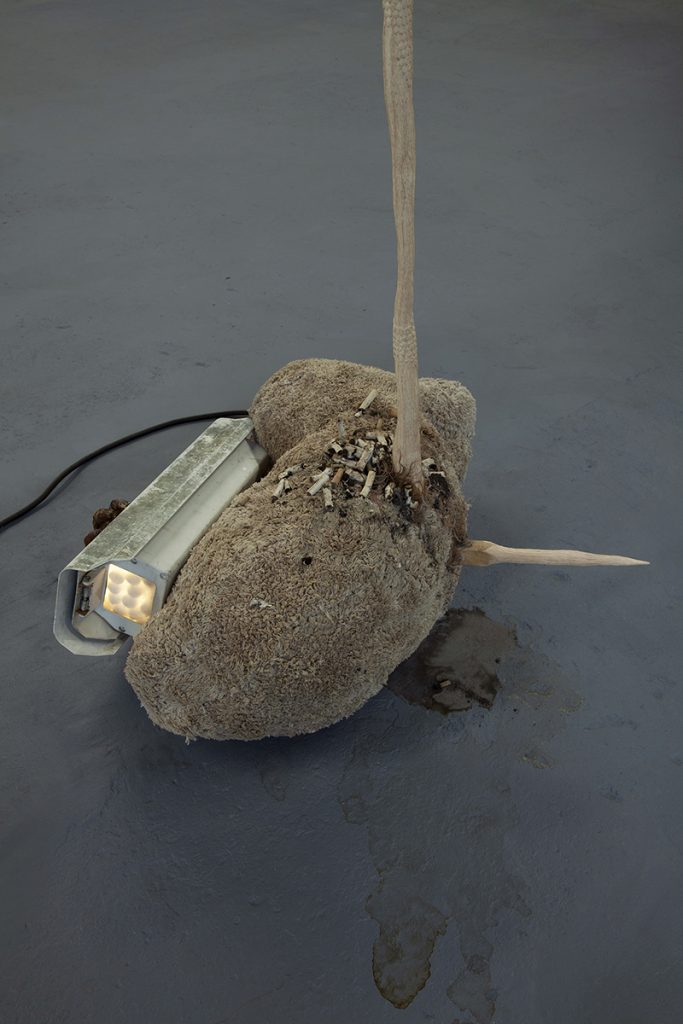
As for the tornado drills… in a way, I am tickled by the notion that these kinds of emergencies can even be responded to at all. They have to be, symbolically, because institutions have liabilities; but beyond that, embedded deeper in the psyche is something very sad or sinister or both. You must be mired in some kind of cognitive dissonance to believe that crouching underneath a school desk will save you. It will make your body easier to find once the building collapses on you. But this belief, this kind of wilful delusion, is a necessary tool to be able to function in the fragile reality of one’s day-to-day under capitalism.
You must know, or convince yourself that there is, in fact, a Plan B. The ‘good’ citizen is supposed to find comfort in the presence of, for example, security cameras, so that if something terrible happens, the ‘authorities’ will be able to refer back and see what occurred. Or, supposedly, the visibility of surveillance will prevent the bad thing from happening in the first place. These are all of the ‘stops’, these supposed measures of protection that are meant to keep things running smoothly, that is, profitably. But they all ultimately unravel, they don’t work. The cognitive dissonance of psychically requiring that they do work, is a kind of rupture which then takes me back—perhaps elliptically—to thinking about the fractured or fragmented body. And how, especially with respect to our current situation in a pandemic, it is the fractured body (or a community of fractured bodies) that has already learned how to live when all the stops have failed.
**Right, this kind of Cold War-era propaganda has no sort of basis in reality but seeks to propagate a false sense of security, while also impressing an American exceptionalism by proposing incommensurately that one can definitely survive an atomic blast by performing this safety precaution devised for tornados. The characters that occupy that propaganda also speak to a kind of racial and political sameness—these white children crumpled under desks—which monopolized an American ideal at that moment in time. And then there is you, as a child, emulating this action and unavoidably entering into that narrative.
CO: I have some vivid memories, from Illinois in the mid 90s, of participating in these safety drills with all the alarm bells ringing and everyone clambering underneath their desks together. It was one of the only situations in which I ever came close to feeling, not quite part of everyone else, but… imagine you and your brother are the only two Asian people in your public school, and ostracized accordingly. Then you are thrown into a situation, this drill, where you and your racist classmates and teachers and administrators are all together, reduced—literally lowered—to face the linoleum floor of your own prospective mortality.
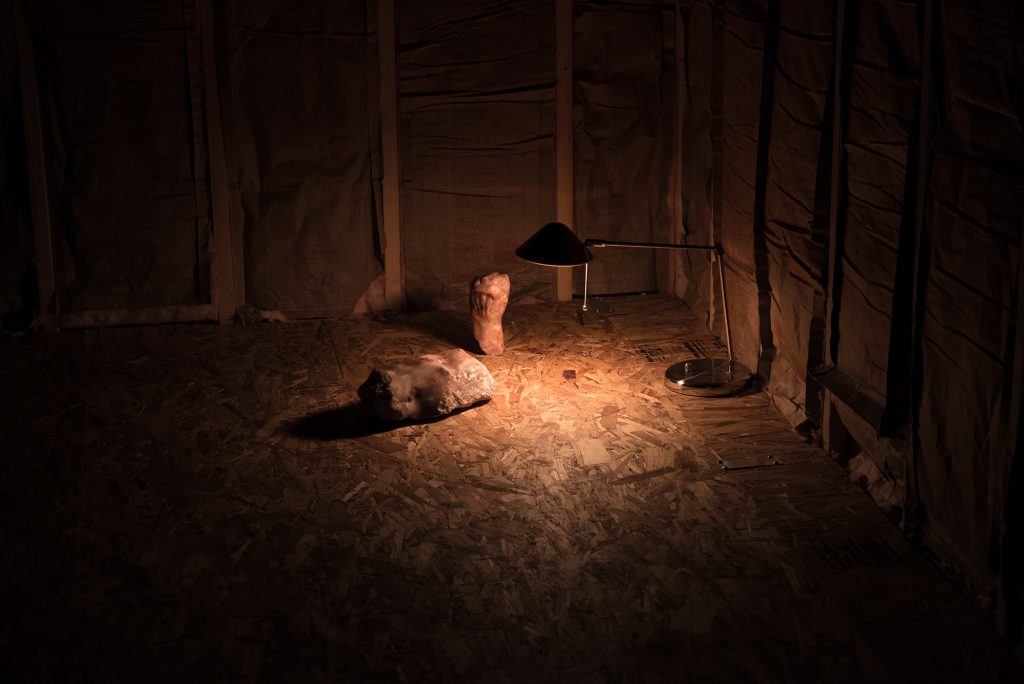
I am not claiming that ‘death is the great equalizer’, because that is not at all true; but I have been thinking about Kaja Silverman’s proposal in Flesh of My Flesh that finitude—the immovable certainty of our eventual end—can push us toward a consideration of what is shared, as opposed to the post-Enlightenment (and capitalistic) fixation on uniqueness and difference. There is something about learning to be ‘prepared’ for crisis or emergency that is at once an erasure of the individual—somehow dehumanizing—but at the same time affirms your flesh as descended from the same cosmic flesh of everything around you.
In Illinois, we rode on the bus for half an hour across a wide cornfield to school; in the middle of our journey, we had to cross a railroad track. The bus would stop, and all the children on board were obliged to put our hands up in the ‘quiet sign’ (a peace sign, basically) on the backs of the bus seats as we waited to make sure that no train would crush us. That shared gesture that we all had to learn and perform became this odd fascist exercise of comfort and control; it brought our flesh into the same shape. That flesh shape eventually contorted and tumbled through my mind, decades later, to become the middle finger of one figure in ‘risk assessment’.
**The body, in a representational sense, is also an access point for a lot of viewers, whether they fall within or outside of an ‘art-educated’ community. It is a way by which you can enter into the work physically by projecting yourself into the object, or whatever the artwork may be. It’s interesting to hear you talk about the work through the realm of ideation because a lot of the imagery you are invoking appears quite literally in the sculptures that make up marrow: the security camera, the school desk with the figure beneath it, the school chairs that have been made into these strange pointed monoliths…
CO: Right. I had spoken with you previously about proprioception—how a body intuitively locates itself in space—and ways of queering and politicizing phenomenology, particularly with respect to Sara Ahmed’s work on phenomenology. The various relations and inversions that marrow’s various figures are involved in reflect the proprioceptive experience of an Othered body, which is perpetually ‘out of sorts’ and must navigate space in ways that are never neutral and never at ease, for it never enjoys a condition of belonging. With the installation ‘last laugh’, in mounting the video on the ceiling facing down, I sought to create a situation that would ask—not force, not require—but ask that, in order to spectate on the frenetic speech of these two avatars, the viewer contort their body in a way sympathetic to the predicament of the heads on the chairs.
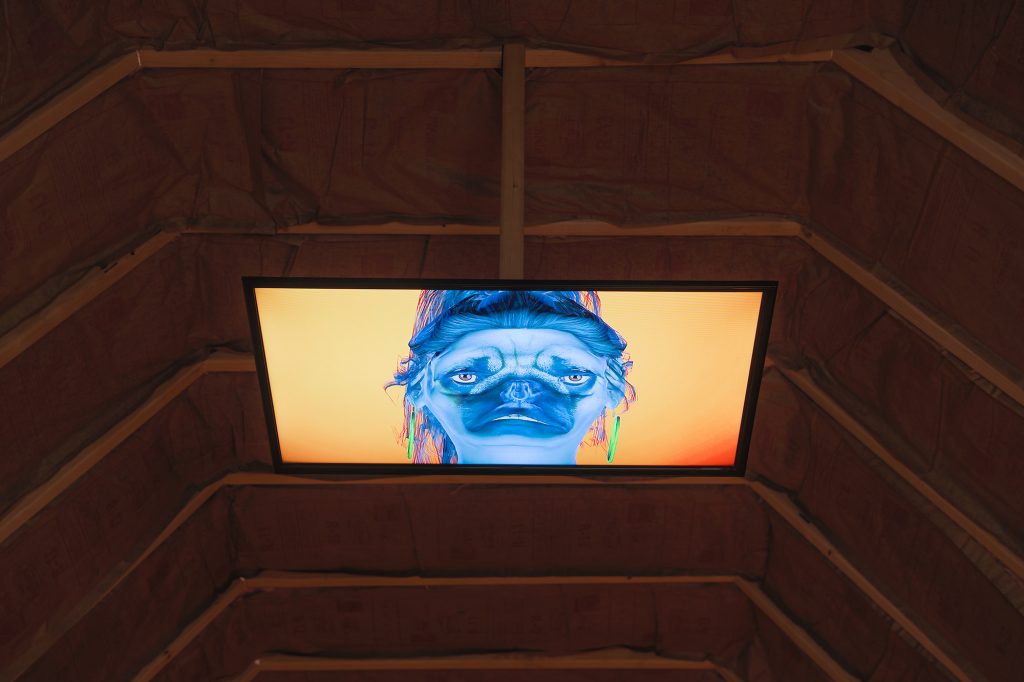
**In the first space of Make Room, which is more of a standard white cube, you have figures contorting away from the viewer in states of shock. In order to engage with them, the viewer has to contort themself as well. This is replicated in the second half of the exhibition—a side room modified to look like an attic in which ‘last laugh’ is installed. In both situations the contortion of the self in order to view the work becomes integral in its reading. Is that what you’re driving at, and the way this relates to the trauma these bodies are experiencing?
CO: I am thinking of the language in ‘last laugh’, which is drawn partially from PTSD surveys, therapy sessions, self-help texts, police questioning, things meant to ‘help’ by maintaining or restoring order—are there points at which it is valuable to embrace or use these measures at face value? One line in the video is quoted directly from my sexual assault counselor, the first therapist I ever found the courage or humility to see: ‘That’s not a feeling, I need you to name your feeling.’ At the time, I could not name a feeling without qualifying it somehow. Because I needed to be better than my feeling, I needed to be a master of it.
We live in an ableist society that glorifies functionality and mastery so that we can continue to be productive contributors. This is something to resist, but perhaps the apparati of ‘being well’ can be repurposed. How does a person live, find joy? What other tools do we have, what tools have we inherited, and how ought they be used or misused?**













